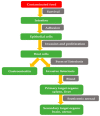Listeria monocytogenes-How This Pathogen Uses Its Virulence Mechanisms to Infect the Hosts
- PMID: 36558825
- PMCID: PMC9783847
- DOI: 10.3390/pathogens11121491
Listeria monocytogenes-How This Pathogen Uses Its Virulence Mechanisms to Infect the Hosts
Abstract
Listeriosis is a serious food-borne illness, especially in susceptible populations, including children, pregnant women, and elderlies. The disease can occur in two forms: non-invasive febrile gastroenteritis and severe invasive listeriosis with septicemia, meningoencephalitis, perinatal infections, and abortion. Expression of each symptom depends on various bacterial virulence factors, immunological status of the infected person, and the number of ingested bacteria. Internalins, mainly InlA and InlB, invasins (invasin A, LAP), and other surface adhesion proteins (InlP1, InlP4) are responsible for epithelial cell binding, whereas internalin C (InlC) and actin assembly-inducing protein (ActA) are involved in cell-to-cell bacterial spread. L. monocytogenes is able to disseminate through the blood and invade diverse host organs. In persons with impaired immunity, the elderly, and pregnant women, the pathogen can also cross the blood-brain and placental barriers, which results in the invasion of the central nervous system and fetus infection, respectively. The aim of this comprehensive review is to summarize the current knowledge on the epidemiology of listeriosis and L. monocytogenes virulence mechanisms that are involved in host infection, with a special focus on their molecular and cellular aspects. We believe that all this information is crucial for a better understanding of the pathogenesis of L. monocytogenes infection.
Keywords: L. monocytogenes; host infection; listeriosis; molecular mechanisms; virulence traits.
Conflict of interest statement
The authors declare no conflict of interest.
Figures


References
-
- Murray E.D.G., Webb R.A., Swann M.B.R. A disease of rabbits characterised by a large mononuclear leucocytosis, caused by a hitherto undescribed bacillus Bacterium monocytogenes (n.sp.) J. Pathol. Bacteriol. 1926;29:407–439. doi: 10.1002/path.1700290409. - DOI
-
- Nyfeldt A. Etiologie de la mononucléose infectieuse. C. R. Sean. Soc. Biol. 1937;101:590–591.
-
- Dhama K., Karthik K., Tiwari R., Zubair Shabbir M., Barbuddhe S., Singh Malik S.V., Kumar Singh R. Listeriosis in animals, its public health significance (food-borne zoonosis) and advances in diagnosis and control: A comprehensive review. Vet. Q. 2015;35:211–235. doi: 10.1080/01652176.2015.1063023. - DOI - PubMed
Publication types
Grants and funding
LinkOut - more resources
Full Text Sources
Research Materials

